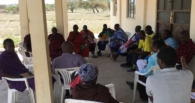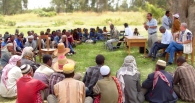Annual World Bank Land and Poverty Conference 2018
Christopher Tanner
9 April 2018
/
- 0 Comments
This year’s 2018 World Bank Land Poverty Conference had the theme of Land Governance in an Inter-connected World. The Conference again brought together well over a thousand people from all over the globe to present and debate the usual massive Agenda of papers and poster presentations. The first day of the five-day event saw several groups of participants and different cooperation partners taking advantage of being in the same place at the same time to hold meetings and talk about their programmes, followed by the opening ceremony later in the afternoon. The Conference then began in earnest with three days of presentations, followed by a final day of Masterclasses.
This year the Conference was marked by the unusual occurrence of a sudden snowstorm which closed the World Bank on the second day of presentations. The Bank follows the lead of the US Federal Government here, and although downtown Washington was busy enough, the Government concern was the large number of people who live outside the city and could not get in. A day later the disruption was over and it was back to spring weather, underlining the bizarre times we all increasingly face as climate change kicks in. But the closure and sudden chill also introduced many of us to the challenge of continuing to take part in a major conference and presenting our papers through a web-based platform from our hotel rooms and lodgings. This in fact worked remarkably well, although the first morning sessions were a bit chaotic as we all figured out how to get into our chosen virtual rooms and which buttons to press when we wanted to say something!
It would be impossible to give an overview of all the presentations and material available, and the reader is advised to click on the link above to the Conference agenda to get a full view of the different issues being discussed. This will also give access to the papers and PowerPoints. I chose a series of presentations loosely structured around gender and land rights, and the over-arching issue of inclusive development where local people and the investors and governments who want their land try to work out reasonably equitable solutions that avoid the ‘land-grabbing’ label.
The first session covered women’s land rights in several countries and included the presentation on the WOLTS women’s land rights research project being implemented by Mokoro under the leadership of Elizabeth Daley. Information on this project, which involves working with communities affected by mining operations in Mongolia and Tanzania, can be found on the Mokoro website. Here, it is useful to underline a key takeaway from these presentations, which is how the presence of women at high government level who are committed to women’s issues impacts on the success of women’s land rights initiatives. One case in particular showed this very clearly. We were told that in Uganda, 30 percent of Members of Parliament and the Minister for Land are women. And, hey presto!, things are happening and there has been a big increase in the number of women owning houses and getting their names onto title documents. In other words, while literally hundreds of projects around the world struggle against entrenched male hierarchies and patriarchal norms and practices, real change only takes place when the gender balance of power changes and there are real shifts in the underlying political economy of the countries concerned.
This theme seemed to dominate things from that point on. I listened to papers that spoke of impressive efforts by civil society and community groups around the world, but where progress seemed too little too late against the tide of national elites working with corporate capital. At least it seems that investors in general are now increasingly aware of the need to work with communities, not just because it is good for corporate images, but also because it is good business – recognising that local rights exist and talking with local people as real stakeholders is the best way to ensure that new projects can be implemented without conflict and are viable over the longer term. A paper on the ‘First Biennial Investor Survey on Land Rights’ also showed how successful ventures in terms of their added-value and share prices were the one that built in land rights issues from the start. Overall, it is evident that investors are now more wary of governments who tell them ‘we have lots of land available’ when they go knocking on doors looking for their many thousands of hectares.
Many presentations underlined how States looking for investors still assume that large-scale investments are the most efficient in terms of productivity and getting under-used land into production. Good questions from the floor in several sessions raised the issue of community farmers producing much higher yields on their remaining small plots of land than the plantations now occupying what were once their fields. The implication here is that attention should focus not on leveraging ‘responsible’ plantation-style investments (using VGGT and RAI approaches to work around community issues), but on working with communities as stakeholders and looking for an entirely different model of investment-led development. It is clear that many governments are still not creating space for local people to engage in serious negotiations with investors. They are either driven by a fear that this approach will put investors off, or they are simply aware that it will mean there is less room for rent-seeking behaviour as they allocate large areas to favoured projects. Taken together, these papers suggest that if governments backed off and facilitated real, tough negotiations between investors and local land users, much more realistic and mutually beneficial agreements could be reached with local farmers and this would reduce the risk of the investment.
Other sessions I attended looked at community-led approaches to documenting and mapping local land rights. My own paper, prepared with my Mozambican colleague Alda Salamão, explored how recognising local rights and developing inclusive community-investor land use plans can achieve the changes in land use patterns that are central to efforts to limit CO2 emissions caused by deforestation linked to itinerant agriculture and unregulated charcoal and logging. In general, there seems to be a growing acceptance of the need to devolve land administration functions down to community level, and to integrate local structures into the land governance architecture of governments. This is to be welcomed and is certainly the best way to ensure a) that land services do reach down to local level; and b) that local rights are genuinely respected and local structures empowered to engage with more powerful external actors.
One paper asked what communities expect from land reform, which of course underlines the point that land reform is rarely about what communities want. Present day land reform is a far cry from earlier revolutionary times, with concepts like Free, Prior and Informed Consent (FPIC) and ‘responsible investment’ offering urban-elites and politicians convenient ways to dress up their plans with cosmetic attempts to buy off local people. In this context ‘land reform’ is rarely something being done for local people and is part of somebody else’s agenda where the real focus is on making money and pursuing the Holy Grail of ‘national development’. On the positive side, however, the conference did reveal signs of a shift towards community empowerment, especially where there have been concerted efforts by organisations like Namati to give legal and rights education to local people and give them the tools to confront governments and investors who would have their land. ‘Land reform’ then begins to take on a very different meaning, of resistance and locally-defined visions, where the pursuit of national development and economic growth are no longer the primary concern of national land administration programmes.
There were some ‘good news’ stories worthy of specific mention. In Ethiopia, after many years of work by projects such as the USAID LAND project supporting national research into rangeland systems and land rights, and advocacy by the International Livestock Research Institute (ILRI) (amongst many others), the government has embarked on a radical policy shift towards recognising the extensive rights of pastoralist communities over the rangeland that they use over the course of different seasons. It is very good to see such things happening, underlining what can be achieved through consistent and well-researched arguments which enable government staff who are aware of realities on the ground to make a case for change when they talk to their political bosses. In the same session, however, other presentations revealed the disastrous impact of large scale land allocations on once-thriving rangeland communities. The Mali paper presented by Camilla Toulmin showed how a large rice project now literally surrounds local villages, wrecking their sophisticated and integrated land use systems, and cutting off traditional grazing and access to water. Camilla first worked in this area in the 1980s and is therefore uniquely able to show how the investment strategy of the government has literally moved the local population from a situation of ‘abundance to scarcity’. Another depressing ‘development’ was revealed in a discussion of how once vibrant Fulani pastoral communities are now little more than herders for the urban elites who now own and control the cattle – and who arm their pastoralist employees to protect their assets and privately-controlled land. This is definitely not development as we at Mokoro see it.
Another interesting paper looked at the real impact of large-scale land allocations on ‘job creation’, which is so often used by governments and investors to justify large land expropriations for private sector projects. Ward Anseeuw, who has lived and worked for many years in Southern Africa, presented the findings of research into the job-creation impact of several large projects. The results are clear – new agricultural enterprises on land once used by smallholder communities are not producing anything like enough jobs for the farmers who have lost their land, and for the millions of rural young who will enter the labour market in the next 15 years. Far more radical approaches are needed, and a focus on large-scale agriculture that dispossesses the rural poor is not one of them.
This last point takes us full circle, to the importance of finding ways to change underlying political economies as a necessary condition for addressing the challenges posed by the Land and Poverty Conference. This year’s Conference revealed many excellent projects around the world, challenging the land governance orthodoxy of governments obsessed with economic growth backed by equally growth-obsessed international institutions and financial sector players. There are shining examples where the much-vaunted ‘win-win’ scenario of investment also bringing real benefits for local people does seem to be within reach. The experiments in local level land management, where local communities are taking charge of land rights processes and acquiring the capacity to negotiate and engage with powerful external interests, are indeed inspiring. These activities, showcased in a high-profile event with the theme of ‘Land Governance in an Interconnected World’, are real signposts to how land governance must evolve if the world is to find a way through to more sustainable and equitable development which is about people and environments, and not just about making money and pursuing economic growth.
RAI – Principles for Responsible Agriculture Investment
VGGT – Voluntary Guidelines on the Responsible Governance of Tenure of Land, Fisheries and Forests in the Context of National Food Security
You must be logged in to post a comment.



